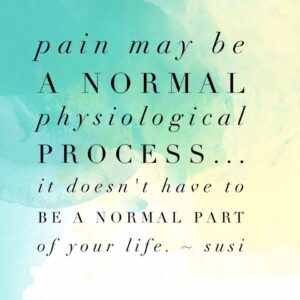 by Susi Hately, BSc. Kinesiology
by Susi Hately, BSc. Kinesiology
Last month, I was teaching an Therapeutic Yoga Training in Vancouver. The premise behind the training is to teach yoga teachers and other health professionals how to help others how to reduce and eliminate pain. As is typical of my trainings, all of the participants had long standing, chronic pain themselves; and they were at the training as much for themselves as they were to learn to help the others with whom they work. And, in the process of learning, they experienced their pain reducing and going away completely. The process was quite awe-inspiring or miraculous at times, since many believed that this pain, tension, tightness is normal – that their back, si joint, neck, wrist and knee pain is “just the way it is”. The realized it wasn’t.
As the training went on each person experienced a change in their body. Their body provided them with a new feeling – something other than pain. As each person had the ah-ha! experience a look of dumbfoundedness was evident on their face. The feeling of less or no pain was almost absurd to them. One person said in disbelief, “this pain has become my friend, it is weird not to have it, I almost want to go looking for it.”
I understand the dumfoundedness and disbelief. I understand the sheer weirdness of moving out of pain and into something more comfortable. It is bizarre…..because it is uncommon.
In Canada there is a commercial for a common pill used as an anti-inflammatory and muscle relaxant. The premise is – “do you think pain is going to stop me?” There is another ad for competitor product with the premise of “what you do when you don’t have pain is up to you”. What these products are selling is “pop this pill to get rid of your pain, and get on with your life.”
This blends well into our cultural psyche (at least in North America). “Pain can’t be really gotten rid of, so let’s mask it and carry on anyway.” Said another way, “Forget about listening to your body, it isn’t saying anything worthwhile, so suppress any sensation and carry on. This pill is your saviour”.
Not one to mask my emotion…this makes me feel really sad. Sad because there is a wealth of understanding within our body that is trying to make itself heard. Sad because there is a belief that we are pieces of Lego stuck together and if we can’t change out a piece of Lego, there is nothing more that can be done. It is sad, sad, sad. We don’t have to rust and wither away. In my over 20 years designing therapeutic programs, I have seen peoples’ bodies shift far too far too many times to discount.
“Well…now what?”
Here is what has worked for the thousands of people I have taught.
1. Try to not fix yourself. There is nothing to fix. If you think or have been told that your sacrum is torsioned “this way” and your one hip bone is lifted “that way”, and your rib cage is moving “in this direction” and your neck in “that direction”, don’t try to make them go the opposite way. The way the body unwinds and unravels tension and awkward holding patterns isn’t often the way we think it will go.
2. Move in as pure of movement as you can, and reduce the compensation that you are aware of. Each of your joints has an optimum range of motion. Whether you are due for a hip replacement, or you have osteoarthritis or rheumatoid arthritis or you are simply darn tight, move the joints in the range that is available. Limit your full body motion to accommodate what your joints are saying to you. Time and time again, those folks who move in their pure range of motion improve alot faster than people who don’t. In fact, the people who don’t….simply don’t improve.
3. Move in a range that doesn’t increase your pain. If you continue to move in pain, your body and particularly your nervous system will see this as an appropriate stimulus and will respond “in kind”. It will give you back tension and pain. If you move with less pain, no pain, or in a range that simply doesn’t increase your pain, your body will shift.
4. And yes, pain doesn’t have to be part of your life. It can reduce, it can be managed, and it can be eliminated.
If you are feeling skeptical about what you read above, give it a go anyway and see what happens. Break these ideas into smaller pieces. Whether it is yoga that you practice, or a series of rehabilitative exercise that you work through, try this – move only as far or as hard that your pain symptoms don’t increase. Then, go about your day as normal. Keep repeating this cycle. Each time that you practice yoga, or you follow the rehabilitative exercises, move in a range that doesn’t increase your pain. Then, go about your day as usual. See what begins to happen. You may just surprise yourself.
Over the years, I have received daily emails from yoga teachers I have trained, who have read my books and who are applying these principles not only in their own practices, but with their students, and ….they are seeing their bodies change and their students’ bodies change as well. I receive emails from friends of clients, people I have never actually met telling me that their pain levels are down by following the principles and actions above. There is a way to get out of pain and/or to significantly reduce the pain you are experiencing. Just give it a try. Let go of cultural psyche, trust in your body. Your body is talking to you. Get quiet. Listen to the whispers. Be curious.
If you do, I guarantee that you won’t have to continue to deal with or suppress the screams..
And as always, happy exploring,
Susi
